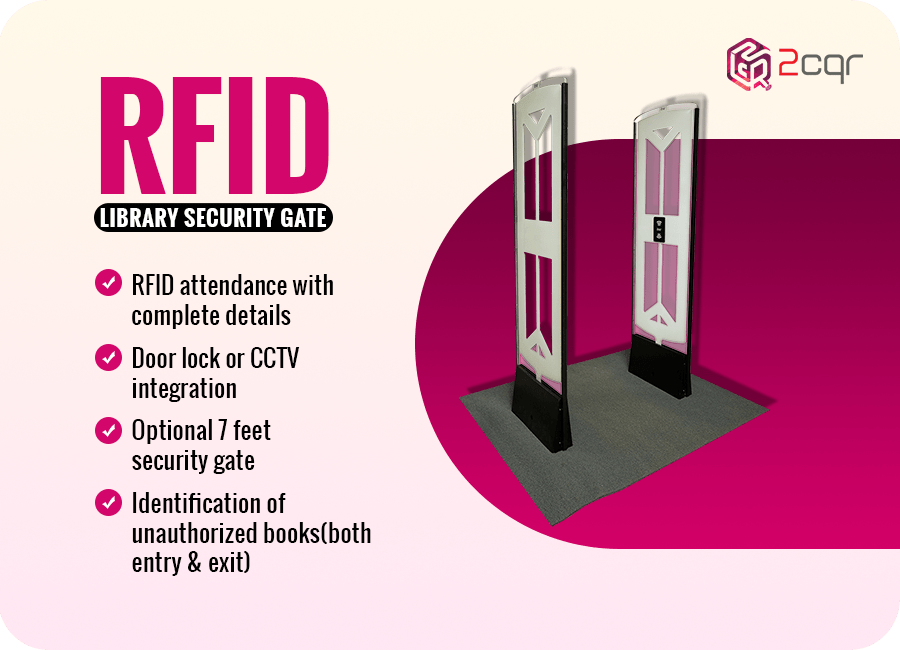
In the world of library management, where the efficiency, speed, and accuracy promised by RFID technology stand as point of progress, there arises a persistent concern – security.
Libraries, the sanctuaries of knowledge, have doubts about embracing RFID in library due to concerns regarding the security of their invaluable collections. Indeed, security emerges as a paramount factor, acting as the base that upholds the reputation and trust of these institutions among their users.
The delicate balance between unlocking the potential of RFID for streamlined library operations and fortifying the security elements is the solution for the challenge faced by libraries worldwide.
However, it’s crucial to recognise that RFID technology not only addresses these security concerns by implementing RFID-based library security systems but also elevates the entire library management experience to unprecedented heights.
Let’s delve into the multifaceted ways in which RFID technology serves as the vanguard of security in libraries, ushering in a new era of trust, efficiency, and cutting-edge management.
Tags or Consumables
RFID tags serve as the crucial point in the seamless execution of library management activities, acting as the silent conductors establishing communication with readers and safeguarding invaluable resources.
The richness of information encoded within these tags becomes the solid foundation of library security measures as it will help the library staff to retrieve the hidden and missed items . These tags, designed with advanced security standards and the integrity of the information housed within these tags becomes the first line of defense, paving the way for a robust security infrastructure within libraries.
Embracing high-quality RFID tags isn’t just an investment in durability but a strategic move to elevate the security architecture, enhancing the library’s ability to protect its collections and maintain an unyielding commitment to uninterrupted, secure operations.
Security Gates
Security gates equipped with RFID technology stand as pillars at the entrance and exit points of libraries, ensuring the safeguarding of valuable data resources. Functioning as vigilant gatekeepers, these security gates ensures the commitment to prevent unauthorized removal of materials.
RFID readers strategically positioned within these gates meticulously scan the RFID tags carried by patrons, creating an intelligent checkpoint for library transactions. In the event of an incomplete or unauthorised transaction, the RFID reader swiftly detects the anomaly and triggers a robust alarm system. This instantaneous response serves as a powerful deterrent, enhancing security by eliminating potential breaches and maintaining the sanctity of library resources.
The real-time functionality of RFID technology in these security systems not only ensures the prevention of theft but also contributes to a seamless library experience. As libraries embrace this integration, they not only improving their security measures but also elevate the overall efficiency and reliability of their operations, marking a significant leap forward in modern library management.
Library Cards
library cards serve as the control points of access and acts as guardians of security within university campuses and educational institutions. These cards play a pivotal role in granting permissions to students, regulating their entry into libraries, and recording a comprehensive log of activities.
By employing RFID technology in library cards, institutions not only facilitate seamless access but also establish an intricate tracking system. This comprehensive tracking captures details such as individual visits, timings, and transactions conducted, laying a solid foundation for preventing theft and fortifying security measures.
The integration of RFID-enabled library cards not only enhances the overall security protocols but also provides valuable insights into library usage patterns, contributing to a proactive approach in managing resources and ensuring a secure library environment for all users.
IoT devices
Implementing access control systems integrated with IoT devices, such as CCTV cameras, within library premises stands as an unbeatable security measure enhanced by RFID technology.
These systems meticulously monitor every user’s entry and exit, transactions, and behavior within the library environment, offering a comprehensive and real-time insight into the library’s dynamics.
The synergy between RFID and IoT not only provides an effective solution for potential theft but also empowers library staff with valuable information to proactively manage and respond to unexpected situations. The fear of being caught, coupled with the precision of monitoring, creates a robust security atmosphere, safeguarding the library’s valuable resources and ensuring a secure space for all users.
The seamless coordination between RFID technology and IoT facilitates a streamlined approach to security, offering libraries a proactive means to preemptively address potential security threats.
Conclusion:
In the realm of library management, the association of RFID technology with security becomes a point of progress, clearing doubts and fortifying trust. From the silent guardianship of RFID tags encoded with rich information to the vigilant sentinels at security gates, RFID ensures a robust defence against unauthorised access and potential theft. The harmonious coordination between RFID technology and IoT creates a symbiotic relationship, offering libraries an advanced and streamlined approach to security, ensuring the sanctity of valuable resources and a secure environment for all users.


